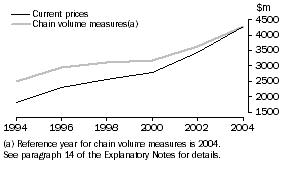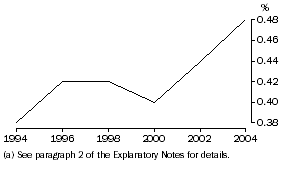Reissue
Research and Experimental Development, Higher Education Organisations, Australia, 2004 (8111.0) is being reissued on Thursday 27 July 2006.
This release corrects two figures contained within the commentary section 'Human Resources Devoted to R&D', no other data is affected by these changes.
NOTES
CHANGES IN THIS ISSUE
Extensive changes have been made to the format and content of this publication. Cross-classifications of data included in previous issues may be available on request.
DATA QUALITY
When interpreting the results in this publication it is important to take into account factors that may affect the reliability of estimates. These factors are described in the Technical Note.
Data presented in this publication may subsequently be revised.
INQUIRIES
For further information about these and related statistics, contact the National Information and Referral Service on 1300 135 070 or Kirsty Rothenbury on Perth (08) 9360 5382.
SUMMARY COMMENTARY
MAIN FEATURES
EXPENDITURE ON RESEARCH AND EXPERIMENTAL DEVELOPMENT (R&D)
Higher education expenditure on R&D (HERD) in Australia in 2004 was $4,283 million. This represented an increase of 24.9% in current price terms over 2002 and 18.0% in chain volume terms.
Resources devoted to R&D |
|  |
 |  |  | 1994 | 1996 | 1998 | 2000 | 2002 | 2004 |  |
|  |
| Expenditure on R&D |  |  |  |  |  |  |  |  |
 | Current prices | $m | 1 830 | 2 308 | 2 555 | 2 790 | 3 430 | 4 283 |  |
 | Chain volume measures(a) | $m | 2 480 | 2 962 | 3 121 | 3 179 | 3 631 | 4 283 |  |
| Human resources devoted to R&D | PYE | 40 096 | 42 739 | 45 502 | 46 287 | 49 612 | 56 809 |  |
|  |
| (a) The reference year for chain volume measures is 2004. See paragraph 14 of the Explanatory Notes for details. |
Over the ten years to 2004, HERD increased at an average annual rate of 13.4% in current price terms and 7.3% in chain volume terms.
Higher Education Expenditure on R&D

Proportion of GDP
HERD as a proportion of gross domestic product (GDP) increased from 0.44% in 2002 to 0.48% in 2004.
HERD as a proportion of GDP(a)

The following table shows HERD/GDP ratios for selected OECD countries.
HERD/GDP ratios of OECD countries |
|  |
 | 2000 | 2001 | 2002 | 2003 | 2004 |  |
 | % | % | % | % | % |  |
|  |
| Sweden | na | 0.85 | na | 0.88 | na |  |
| Canada | 0.55 | 0.59 | 0.65 | 0.69 | 0.73 |  |
| Finland | 0.60 | 0.61 | 0.66 | 0.67 | na |  |
| Switzerland | 0.59 | na | 0.64 | na | na |  |
| Iceland | 0.45 | 0.58 | 0.51 | 0.63 | na |  |
| Denmark | 0.45 | 0.45 | 0.58 | 0.60 | na |  |
| Netherlands | 0.53 | 0.51 | 0.52 | na | na |  |
| Norway | na | 0.41 | 0.45 | 0.48 | na |  |
| Australia | 0.40 | na | 0.44 | na | 0.48 |  |
| Japan | 0.43 | 0.44 | 0.43 | 0.43 | na |  |
| Turkey | 0.39 | 0.43 | 0.43 | na | na |  |
| Germany | 0.39 | 0.40 | 0.42 | 0.43 | 0.41 |  |
| France | 0.40 | 0.42 | 0.42 | 0.42 | 0.41 |  |
| United Kingdom | 0.38 | 0.40 | 0.42 | 0.40 | na |  |
| Belgium | 0.41 | 0.42 | 0.40 | 0.40 | na |  |
| Italy | 0.33 | 0.36 | 0.38 | na | na |  |
| United States of America | 0.31 | 0.33 | 0.36 | 0.37 | 0.36 |  |
| New Zealand | na | 0.35 | na | 0.33 | na |  |
| Spain | 0.27 | 0.28 | 0.29 | 0.32 | na |  |
| Ireland | 0.23 | 0.24 | 0.25 | 0.30 | 0.33 |  |
| Portugal | 0.30 | 0.31 | 0.30 | 0.30 | na |  |
| Greece | na | 0.29 | na | 0.30 | na |  |
| Korea | 0.27 | 0.27 | 0.26 | 0.27 | na |  |
| Hungary | 0.19 | 0.24 | 0.26 | 0.26 | 0.22 |  |
| Czech Republic | 0.18 | 0.19 | 0.19 | 0.19 | 0.19 |  |
| Poland | 0.21 | 0.21 | 0.20 | 0.18 | na |  |
| Mexico | 0.11 | 0.12 | na | na | na |  |
| Slovak Republic | 0.06 | 0.06 | 0.05 | 0.08 | 0.11 |  |
|  |
| na not available |
| Main Science and Technology Indicators, 2005/2, OECD, Paris, 2005 |
Type of expenditure
In 2004, HERD was comprised of $4,007.7 million in Current expenditure and $275.1 million in Capital expenditure. As in 2002, the largest component of HERD in 2004 was Labour costs, which totalled $1789.2 million (41.8% of HERD).
Source of funds
The majority of HERD in 2004 was sourced from General university funds ($2,964.6 million or 69.2% of HERD) and Australian competitive research grants ($739.6 million or 17.3%). These were also the major sources of funds in 2002.
Type of activity
In 2004, 40.8% of HERD ($1745.6 million) was directed towards Applied research, 28.7% ($1229.8 million) to Pure basic research, and 22.9% ($978.8 million) to Strategic basic research. The remaining 7.7% of HERD ($328.6 million) was comprised of Experimental development. The distribution of HERD across types of activity was largely unchanged from 2002.
Research fields
Almost half (46.9%) of HERD in 2004 was devoted to research in the fields of Medical and health sciences ($1,082.4 million), Engineering and technology ($473.9 million) and Biological sciences ($451.0 million).
Socio-economic objectives
More than a quarter (27.9% or $1,197.0 million) of HERD in 2004 was directed at Health related socio-economic objectives (SEOs). This included the understanding and treatment of clinical diseases and conditions and the provision of public health services.
The next most prevalent SEO was Non-oriented research, which accounted for 20.0% ($855.3 million) of HERD. This included R&D contributing to the general advancement of knowledge without having a specific application.
There was little change in the distribution of expenditure across SEOs between 2002 and 2004.
State and territory
As in previous years, the majority of HERD (69.1%) in 2004 was located in New South Wales ($1,192.8 million), Victoria ($1,052.6) and Queensland ($715.6 million).
Between 2002 and 2004, New South Wales recorded the largest growth HERD in absolute terms (up $200.9 million or 20.3%), while Western Australia recorded the fastest rate of growth (up 49.4% or $146.2 million). All states and territories recorded increases in their expenditure on R&D as a proportion of gross state product (GSP).
HERD as a proportion of GSP(a), by location |
|  |
 | NSW | Vic. | Qld | SA | WA | Tas. | NT | ACT |  |
 | % | % | % | % | % | % | % | % |  |
|  |
| 2002 | 0.36 | 0.44 | 0.43 | 0.48 | 0.35 | 0.50 | 0.30 | 2.18 |  |
| 2004 | 0.39 | 0.47 | 0.45 | 0.54 | 0.44 | 0.52 | 0.32 | 2.39 |  |
|  |
| (a) See paragraph 2 of the Explanatory Notes for details. |
HUMAN RESOURCES DEVOTED TO R&D
Australian higher education organisations devoted a total of 56,809 person years of effort to R&D in 2004, up 14.5% from 49,612 in 2002. Most of the human resources devoted to R&D in 2004 were Postgraduate students (57.2%) and Academic staff (26.8%), with the remainder being Other staff who directly supported R&D.
As with HERD, New South Wales, Victoria and Queensland accounted for the majority (71.8%) of person years of effort devoted to R&D in 2004.
 Print Page
Print Page
 Print All
Print All